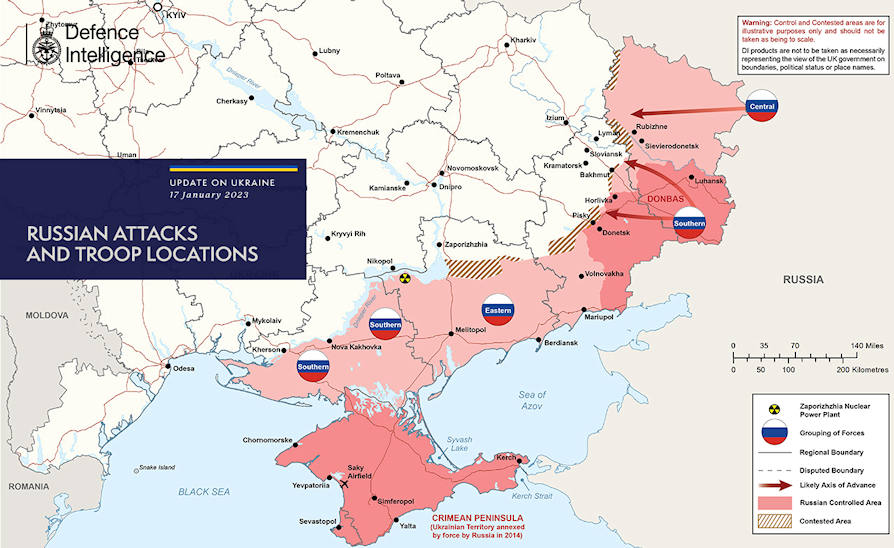In the last weeks of 2022, the consolidation of the "stratified" Russian defensive line east of the Dnepr river and the trenches dug in the Donbass seemed to confirm the usefulness for Moscow of slowing down military operations in Ukraine. And yet, "slowdown" is not the same as "stasis", on the contrary, the need for movement and action aimed at tactical adjustments and, where possible, also at reversing the strategic initiative, is clearly present. Likewise, slowing down operations does not at all equate to the political will to start negotiations with Kiev and it is far more probable that the Russians will need time to start exploiting the beneficial effects - real or only presumed the battlefield will tell - of the partial mobilization and therefore of the greater availability of troops and resources; benefits to date not yet calculable since, but it was already said in Russian military circles at the time of Putin's mobilization announcement, the measures for the organic increase of troops would not lead to substantial changes before six to seven months .
General Surovikin's strategy itself (which remains the one to follow despite Gerasimov having taken over the command since 11 January), based on in-depth pressure against Ukrainian infrastructure and logistics chains, can only have results of a certain type if it can then be have highly maneuverable and well-armed forces which, to date, Russia is unable to deploy.
In this regard, we underline the choice not to immediately throw the reservists and newly mobilized troops who still need training and updating into the fray, preferring to rely on more experienced units in key sectors, such as the massive presence of Wagner mercenaries in Soledar (according to British intelligence, fighters from Yevgeny Prigozhin's company make up 10% of the total forces employed by the Russians in Ukraine) indicates.
 The Russian offensive currently underway along the Berestove-Klishchiivka line, with epicenter Bakhmut, in the Donbass, highlights the importance of that front in which the real game of war is being played, despite in some moments, especially in the phase immediately following the great last summer's Ukrainian counter-offensive, appeared to most as a scenario of secondary importance with respect to the vast strip of the Dnieper and the south-western coast.
The Russian offensive currently underway along the Berestove-Klishchiivka line, with epicenter Bakhmut, in the Donbass, highlights the importance of that front in which the real game of war is being played, despite in some moments, especially in the phase immediately following the great last summer's Ukrainian counter-offensive, appeared to most as a scenario of secondary importance with respect to the vast strip of the Dnieper and the south-western coast.
In the battle around Bakhmut the same pattern of the clashes for the conquest of Sievierodonetsk and Lysychansk seems to be reproduced, with the Russians who first surrounded and then attacked deep into the center of the cities and the Ukrainians who opted for an all-out defence, unleashing make one materialslacht, with the aim of acting as an "anvil", attracting as many enemy forces as possible in a restricted scenario and preventing the immediate breakthrough of a large portion of the front line.
The Ukrainian defensive deployment hinges on Kramatorsk and the conquest of Bakhmut by the Russian side would most likely trigger a new "tactical crisis" for the forces of Kiev. At present it is difficult to imagine how far the Russians can go, also in the light of the above considerations regarding their real ability to carry out a large-scale offensive, but at the same time, the risk of crisis of the defensive system in the Donbass , explains the resistance "to the last man" of the Ukrainians.
A strategy of slowing down operations while waiting for better times, which does not "drag" with it a wait-and-see tactic, but almost imposes activism, is proof that all the rhetoric and old analyzes based on the myth of "General Winter" have also been definitively overtaken by the war between Russia and Ukraine. There is no longer a 'lunch' and both sides are, in various sectors, on the offensive.
 As absurd as it may seem, whoever does not have the initiative in the field is obliged not to crystallize the front and this explains why Russian troops have unleashed an offensive in the Donbass at this stage.
As absurd as it may seem, whoever does not have the initiative in the field is obliged not to crystallize the front and this explains why Russian troops have unleashed an offensive in the Donbass at this stage.
Since the beginning of December, President Vladimir Putin has begun to speak publicly about the preparations underway for a protracted war, also reflecting on the strategic and tactical errors that Russia has so far committed in conducting operations in Ukraine.
Putin has identified four priorities: the improvement of the mobilization process, the revitalization of the production system of the military-industrial complex, the strengthening of state controls over the media and the increase of powers in the hands of the Ministry of Defence. It remains to be seen how much of this complex political-military program desired by the Kremlin can actually be implemented in the coming months.
In the meantime, the Russian hammer strikes violently in the Donbass, hoping for the Ukrainian "tactical crisis" or, at least, for the impossibility of a reaction from Kiev.

Photo: MoD Russian Fed / MoD UK












